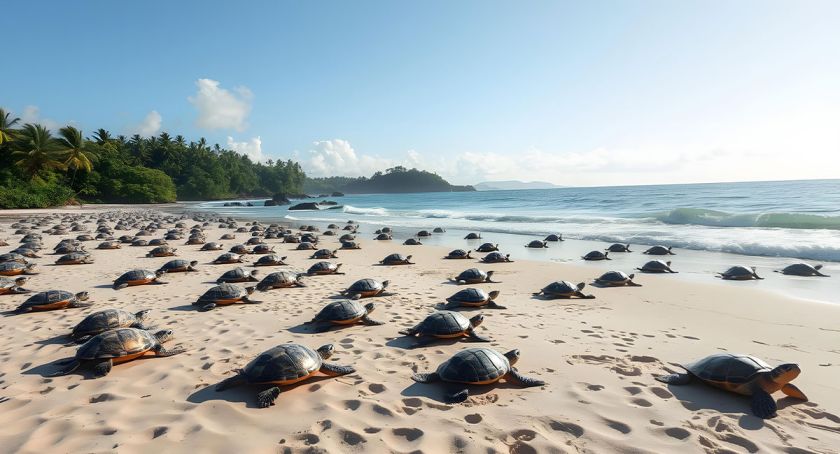Olive Ridley Turtles at Gahirmatha, Odisha
Odisha, known for its rich biodiversity and scenic coastal beauty, is home to one of nature’s most fascinating phenomena—the mass nesting of Olive Ridley turtles at Gahirmatha Beach. This pristine beach in the Kendrapara district is the largest rookery for these magnificent marine creatures worldwide. Every year, thousands of Olive Ridley turtles embark on an incredible journey to lay their eggs in the sands of Gahirmatha, making it a spectacle that attracts nature enthusiasts and conservationists alike.
The Olive Ridley Turtles: An Overview
The Olive Ridley turtle (Lepidochelys olivacea) is one of the tiniest and most prevalent marine turtle species in warm tropical waters. These turtles, who get their name from the olive-green hue of their shell, are well-known for their unusual mass nesting habit known as “arribada,” in which thousands of females come ashore at once to lay eggs. The International Union for Conservation of Nature (IUCN) has designated them as “Vulnerable” despite their vast numbers because of concerns like habitat degradation, poaching, and unintentional entrapment in fishing nets.
Gahirmatha: The Largest Rookery in the World
Gahirmatha Beach is the world’s largest nesting site for Olive Ridley turtles. Situated between the Brahmani and Baitarani river deltas, this coastal stretch provides a perfect environment for these turtles to lay their eggs. The location is a part of the protected Bhitarkanika National Park, vital to the species’ preservation.
Every year, between November and March, female Olive Ridleys travel thousands of kilometers to reach Gahirmatha. Under darkness, they dig nests in the sand and lay 100–150 eggs each before returning to the sea. After an incubation period of about 45–50 days, the hatchlings emerge and go to the ocean—a journey fraught with challenges, as predators such as birds and crabs pose a constant threat.
Conservation Efforts at Gahirmatha
Given Gahirmatha’s significance as a nesting ground, conservationists have implemented efforts to protect the Olive Ridley turtles. The Odisha Forest Department and various wildlife organizations have taken several measures to safeguard the turtles and their habitat. Some of the key conservation initiatives include:
- Marine Sanctuary Designation – In 1997, authorities established Gahirmatha Marine Sanctuary to create a protected zone restricting fishing and other disruptive activities during the nesting and hatching seasons.
- Ban on Trawlers and Fishing Nets – In designated areas, authorities strictly prohibit mechanized trawlers and gill nets, which often lead to turtles’ accidental entanglement and drowning.
- Awareness Campaigns – Educate local communities and fishermen about the importance of Olive Ridley turtles and the need to protect them.
- Patrolling and Monitoring – The forest department regularly patrols with non-governmental organizations to prevent poaching and illegal activities.
- Artificial Hatcheries – To increase the survival rate of hatchlings, conservationists collect vulnerable eggs and relocate them to protected hatcheries where they can safely develop.
Challenges and Threats
Despite these efforts, the Olive Ridley turtles at Gahirmatha face numerous challenges threatening their survival. Some of the major threats include:
- Habitat Destruction – Coastal development, beach erosion, and pollution impact the nesting sites, making it difficult for turtles to find suitable locations to lay their eggs.
- Climate Change – Rising temperatures can affect the incubation process, leading to skewed sex ratios among hatchlings, as temperature determines the sex of baby turtles.
- Illegal Fishing Practices – Despite the ban, some fishermen continue to use trawlers and nets, which results in the accidental capture of turtles.
- Predation – Natural predators such as jackals, dogs, and birds often feed on turtle eggs and hatchlings, reducing the number of young turtles that reach the sea.
- Human Disturbance – Increased tourism and human activities along the coast can disrupt the turtles’ nesting process, causing them to abandon their nesting attempts.
The Role of Ecotourism in Conservation
While human activities pose challenges, responsible ecotourism can significantly contribute to preserving Olive Ridley turtles. Sustainable tourism initiatives, such as guided turtle-watching tours and eco-lodges, can generate revenue for local communities while promoting conservation efforts. Visitors to Gahirmatha’s breathtaking view of turtles breeding and hatchlings heading out to sea foster a greater respect for marine life.
To ensure minimal disturbance to the turtles, ecotourism guidelines include:
- Keeping a safe distance from hatchlings and turtles that are nesting.
- Avoid using bright lights or flash photography, as turtles are sensitive to artificial lighting.
- Following the instructions of wildlife guides and conservationists to minimize human impact.
The Future of Olive Ridley Turtles at Gahirmatha
The survival of Olive Ridley turtles at Gahirmatha depends on continued conservation efforts, policy enforcement, and community involvement. Strengthening marine protection laws, increasing awareness, and promoting eco-friendly tourism can help safeguard these turtles for future generations.
Scientific research and international collaborations can also contribute to understanding Olive Ridley turtles’ migration patterns and behavior, leading to better conservation strategies. To reduce human-induced threats, authorities must enforce sustainable fishing practices and stricter regulations against illegal poaching.
Conclusion
Gahirmatha’s Olive Ridley turtles are a natural wonder that showcases the beauty and resilience of marine life. Their annual migration and mass nesting event remind them of nature’s complex balance and the importance of conservation. While challenges persist, the dedicated efforts of conservationists, local authorities, and communities provide hope for the future of these remarkable sea turtles. By promoting responsible tourism, enforcing protective measures, and spreading awareness, we can ensure that the shores of Gahirmatha remain a haven for Olive Ridley turtles for generations.


